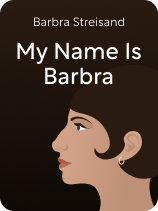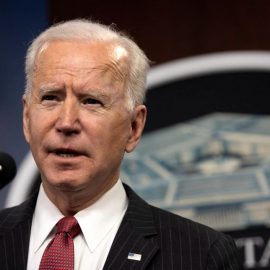

This article is an excerpt from the Shortform book guide to "My Name Is Barbra" by Barbra Streisand. Shortform has the world's best summaries and analyses of books you should be reading.
Like this article? Sign up for a free trial here.
What’s Barbra Streisand’s background? How does she view herself? What does she value most?
My Name Is Barbra, Barbra Streisand’s memoir, tells us about the personal and professional life of one of the most successful and well-rounded performers in history. In addition to her career, Streisand is also known for being a feminist, environmentalist, and philanthropist.
Continue reading for an overview of this 1,000-page autobiography.
Overview of My Name Is Barbra (Barbra Streisand’s Memoir)
Barbra Streisand has starred in movies, plays, and television specials, and she’s recorded dozens of studio albums. As a testament to her career, Streisand is an EGOT winner (Emmy, Grammy, Oscar, and Tony awards), a feat that only 24 people have achieved. Among her numerous personal accomplishments are creating the Streisand Foundation and endowing the Barbra Streisand Center at UCLA.
In our overview of My Name Is Barbra (Barbra Streisand’s memoir), we’ll take you through this remarkable life, as told by Streisand herself. We’ll begin by examining who she is as a person—how she was raised and how she describes herself throughout this memoir. We’ll then describe the various romantic relationships that have punctuated her personal life, starting with her first husband Elliott Gould and ending with her current husband, James Brolin. Next, we’ll explore Streisand’s extensive career as a performer, including her work onstage, in movies, in the music industry, and on TV. Finally, we’ll discuss Streisand’s legacy: her philanthropic work and what she hopes to leave behind after she dies.
Streisand’s Upbringing and Self-Perception
Barbra Streisand (which she emphasizes is pronounced “stry-sand,” not “stry-zand”) is a star of theater, movies, television, and music—but, before that, she was a child from a troubled family.
We’ll discuss Streisand’s upbringing and how it affected her. Then we’ll talk about how she sees herself—perceptions that are, in part, shaped by that difficult childhood.
Streisand’s Troubled Childhood
The author was born Barbara (with an a) Streisand on April 24, 1942. She was born and raised in Brooklyn, New York. She says that her childhood was unhappy, even traumatic. Streisand’s father Emanuel died unexpectedly when she was only 15 months old. She describes her mother Diana as self-absorbed and emotionally distant. For example, instead of empathizing with Streisand’s dream to be an actress and supporting her, Diana often said that she (Streisand) wasn’t pretty enough to be a star and should give up.
Diana couldn’t support the family on her own, so they moved in with her parents. As a result, Barbra lived in a one-bedroom apartment with four other people: her mother, her brother Sheldon, and her maternal grandparents Louis and Esther Rosen.
When Streisand was eight years old, her mother began dating—and eventually married—a man named Louis Kind, allowing them to finally move out of the small apartment. However, Kind mistreated Diana and was emotionally abusive toward the children; Streisand says he seemed to resent her and Sheldon simply for existing.
Streisand says that, because of her difficult childhood, she has always loved escapism. As a child and a teenager, she attended movies and Broadway shows whenever she could; she found fiction more engaging than real life. This undoubtedly contributed to her love of acting and performing.
How Streisand Describes Herself
When talking about herself, Streisand says that, no matter how famous she gets, she still thinks of herself as just a silly Jewish girl from Brooklyn. She says she tends to forget what other people think of her, so she’s often surprised when strangers recognize her or when other celebrities want to meet her.
Relatedly, Streisand credits much of her success to luck, rather than to her efforts. For instance, she says that she just happened to be born with a talent for singing and happened to have met the right people at the right times to help her career take off. She’s also her own harshest critic—she rarely enjoys watching or listening to her performances because she can only see what’s wrong with them.
On the other hand, Streisand says that she’s always been strong-willed and outspoken, even as a child; for instance, she was usually able to get her mother to do what she wanted. As an adult, she tends to speak her mind and isn’t overly concerned with manners. For example, she describes making glib remarks upon meeting many different celebrities and even heads of state, such as asking Queen Elizabeth II why women had to wear gloves to shake her hand but men didn’t.
Streisand’s Key Value: Honesty
Streisand says she hates it when people tell lies. This is because people frequently told her lies while she was growing up and frequently lied about her once she became famous. Furthermore, people tend to believe whatever they read, even when people who know her personally say it’s wrong.
In fact, Streisand’s devotion to the truth is a major part of why she finally agreed to write this autobiography.
Streisand’s drive for authenticity is a running theme throughout her career as well. For instance, she refused to get plastic surgery for her prominent nose, even though numerous people said that doing so would make her more popular (because she’d be more conventionally attractive).
However, Streisand did make one concession by changing the spelling of her first name: “Barbara” to “Barbra,” dropping the second “a.” The pronunciation is the same, and she says the unusual spelling is eye-catching, which helps her stand out as a performer.
Streisand also insisted on staying true to herself during shows. As a young singer performing in nightclubs, she always chose songs that were meaningful to her personally, even if they weren’t quite appropriate for the venue. For instance, she tended to start her acts by singing a ballad, while most performers would open with something uptempo to engage the audience.
This is also true of Streisand’s performances in plays and movies. Even though she portrayed fictional characters, she says that she always strove to feel and perform with genuine emotions. Faking feelings has never come easily for her—for instance, she says she can’t cry on command and only does so when a scene moves her to real tears.
Streisand’s Love Life
Although she’s played countless romantic leads on stage and screen, Streisand says that her real love life has been difficult.
First of all, when she was younger, Streisand was distrustful of men because of how her stepfather treated her and her mother. She says that, partly as a result of that treatment, she didn’t start dating seriously until adulthood.
Furthermore, Streisand tended to fall for men who were already in relationships. She thinks that’s because, as a child, she got used to being lonely. Chasing unavailable men was therefore a “safe” option because she was guaranteed to end up alone again sooner or later; either the man would turn her down, or they’d have a brief affair before he went back to his partner. Streisand believes that, subconsciously, this might have been less frightening for her than the possibility of a real, long-term relationship with someone.
We’ll discuss Streisand’s marriage to her first husband, Elliott Gould. Then we’ll mention some of her other noteworthy relationships before concluding with her second (and current) marriage to fellow actor James Brolin.
Streisand’s First Husband: Elliott Gould
Streisand says she met Gould, who would later become her first husband, in 1962. He was playing the male lead in I Can Get It for You Wholesale, the first Broadway show that Streisand was cast in.
Streisand and Gould started getting dinner together after rehearsals—first just as friends, then as a couple. They got married in 1963. Streisand was 21 years old at the time; she says that, in hindsight, that seems much too young for marriage.
Streisand and Gould’s marriage was often rocky. First, Gould resented that Streisand quickly became more successful than him. Second, he had a gambling problem, and he frequently wagered or sold their possessions to support it.
In 1966 Streisand gave birth to their son, Jason Gould, whom she loved dearly (and still does today). Streisand frequently brought Jason with her to rehearsals and film shoots, rather than having to hire a babysitter, and she enjoyed having him around while she was working.
Near the end of their relationship, Gould started heavily using cannabis and possibly other drugs. Streisand says that she doesn’t take drugs—she tried cannabis once but didn’t enjoy it—and she was uncomfortable with Gould using drugs, especially around their son.
Streisand and Gould announced their separation in 1969 and finalized their divorce in 1971.
Other Romantic Relationships
Streisand had several other romantic partners in between her first and second marriages—we’ll discuss two that are especially noteworthy.
Anthony “Tony” Newley: An actor and singer like Streisand whom she got involved with in 1969—shortly after announcing her separation from Gould, but before their divorce. She says that Newley was charming and passionate. They broke up after Newley did something that badly upset Streisand, though she doesn’t say what. More than 20 years later, Newley sent her a recording of a song he’d written. In it, he lamented having lost her and blamed himself for their breakup. That was the last contact the two had before Newley died in 1999.
Jon Peters: A hairstylist whom Streisand met when she asked him to design a wig for her. She describes Peters as being bold and outspoken. For instance, at their first meeting, he scolded Streisand for keeping him waiting; shortly after that, he crudely complimented her body. Streisand says that she actually enjoyed this treatment—Peters acted like his authentic self and talked to her as if she were a regular person. However, Peters used her money to buy a house in his name and to pay for landscaping and construction projects that Streisand hadn’t agreed to, prompting her to end the relationship.
Streisand’s Current Husband: James “Jim” Brolin
Streisand describes her current husband, James Brolin, as attractive, considerate, and very masculine. Her favorite thing about Brolin is that he doesn’t feel threatened by her success and doesn’t try to hold her back professionally; on the contrary, he encourages her to pursue opportunities and helps in any way he can.
Streisand explains that she met Brolin in 1996 at a dinner party hosted by one of their mutual friends. He was sporting an unusual haircut that day, and Streisand’s first words to him were to ask who had messed up his hair. Far from being offended, Brolin—a professional actor like Streisand—was pleasantly surprised to meet someone in the industry who spoke her mind freely and honestly. They didn’t speak to anyone else for the rest of the party, and then they went back to Streisand’s home where they kept talking late into the night.
Streisand and Brolin lived together for about two years before getting married in 1998, and they’ve been happily married ever since.
Streisand’s Career
Streisand’s career as a performer is what she’s best known for. We’ll describe the manager who supported Streisand’s success, then we’ll discuss Streisand’s remarkable achievements in theater, as a singer, on television, and in movies.
Streisand’s Manager
While discussing her early career, Streisand introduces Martin “Marty” Erlichman, a personal manager who went backstage to speak with her after watching one of her shows. During that first meeting, Erlichman correctly predicted that she would become an EGOT winner (short for someone who’s won Emmy, Grammy, Oscar, and Tony awards), and he offered to represent her in the entertainment industry. Erlichman was her career manager from then on, meaning he negotiated the contracts for nearly everything she did.
Theatrical Work
Streisand got her first acting credits at the age of 15, as an apprentice at Malden Bridge Playhouse. Her first role was a small part in a play called Teahouse of the August Moon. That same summer, she played a flirtatious office worker and a plain, bookish girl; though those roles were very different from each other, she received positive reviews for both. Streisand says that she felt miscast in some of the roles she played during her apprenticeship, but she didn’t care—she was just happy to finally be onstage.
With Erlichman’s support, Streisand landed her first Broadway role at the age of 19: a young secretary named Miss Marmelstein in the play I Can Get It for You Wholesale.
In 1964, Streisand starred in Funny Girl as legendary vaudeville performer Fanny Brice. She adds that she was competing with some of the biggest names of the day for that part, including Carol Burnett and Anne Bancroft; being cast over such popular stars was proof of Streisand’s stardom.
Streisand adds that she was nominated for Tony Awards for both of the aforementioned shows, but she didn’t win. However, in 1970, she was presented with a Special Tony Award for Star of the Decade. She says that award moved her deeply because it came from the theater community, which she’d come to view as her family.
Singing
Streisand says that, at first, she had trouble making ends meet as an actor, so she started singing at nightclubs to earn extra money. She adds that she only took a single music lesson; everything the teacher told her felt wrong and went against her instincts, so she decided to keep singing the way that came naturally to her.
However, Streisand was able to use her acting training to emotionally connect with the songs she sang. She started thinking of each song as a miniature story with a clear beginning, middle, and end, so she invented characters and performed the songs as if she were in a musical, instead of simply singing them as herself.
At 18 years old, Streisand started performing at a nightclub called the Bon Soir and quickly became an audience favorite. That was the start of her singing career. Streisand adds that, two years later, she returned to the Bon Soir for a two-week contract as a special headliner, which was a sign of how far her singing career had come.
A few months later, Streisand signed a contract with Columbia Records to make an album. The contract Erlichman negotiated gave her creative control: She decided which songs would be on the album, and it couldn’t be released to the public until she approved it. Streisand says that such an arrangement was unheard of for someone recording their first album.
Streisand recorded the album, simply titled The Barbra Streisand Album, in 1963. It won two Grammy Awards: Best Female Vocal Performance and Album of the Year.
Movies
Streisand says that anything she performs onstage is gone as soon as the show ends, but movies last forever. She finds it satisfying and reassuring to know that something she made will outlast her.
Streisand’s first role in a movie was reprising the role of Fanny Brice from Funny Girl. She says that she was nervous to be on the big screen because she didn’t look like other movie stars of the time, such as Marilyn Monroe, and she thought audiences would reject her because of it. However, that wasn’t the case; Streisand won her first Oscar (Best Actress) for her role in Funny Girl.
Streisand has starred in many movies, but her most commercially successful role was as Esther Hoffman in the musical drama A Star Is Born. This was also the most profitable movie for her, since her contracted pay included a percentage of the gross earnings (though she doesn’t say exactly how much she made for that role).
A Star Is Born includes the song “Evergreen,” which earned Streisand another Oscar (for Best Original Song). “Evergreen” also won three Grammy Awards: Best Female Pop Vocal Performance, Best Arrangement, and Song of the Year.
Directing
Streisand adds that she’s come to dislike a lot of the tedious work that comes with acting, such as learning lines and spending hours each day getting her hair and makeup ready. She finds directing to be more difficult than acting, but also more interesting and more fulfilling.
Streisand has directed numerous movies, but the most noteworthy of these is her first: the 1983 musical drama Yentl, which she also co-wrote, co-produced, and starred in.
Yentl won a Golden Globe award for Best Picture, and Streisand became the first woman to receive a Golden Globe for Best Director.
Television
While Streisand’s work in television isn’t as well-known, she has numerous television credits to her name and has won multiple Emmy awards for her work in various TV shows and specials. Streisand’s first TV special aired in April of 1965. The program was titled My Name Is Barbra, and it featured her singing the songs from her new album of the same name.
The TV special was nominated for six Emmy Awards and won five of them,with Streisand herself winning the award for Individual Achievement by an Actor or Performer. However, she adds that she felt the greatest honor was when My Name Is Barbra won the Peabody Award for excellence.
Barbra Streisand’s Legacy
Despite her extraordinary career, Streisand—who’s now in her 80s—doesn’t discuss her work when talking about her legacy. Instead, she says that her twin passions are politics and philanthropy; she wants to leave a kinder and fairer world for future generations.
Politics
Streisand describes herself as a feminist and a liberal; she holds up her life and career as testaments to those words.
Professionally, she shattered numerous glass ceilings in the entertainment industry, proving that women can be just as creative and successful as men. To people who respond negatively to her desire for creative control by calling her overbearing or a “control freak,” she asks why it’s a bad thing for a woman to manage her own projects when it’s expected for a man to do so.
Streisand openly supports liberal politicians. She performed at a fundraiser for Bill Clinton when he was running for president; she also supported Hilary Clinton’s 2008 campaign, then shifted her support to Barack Obama when he won the nomination. She adds that she was horrified by Donald Trump’s presidency and wrote the song “Don’t Lie to Me” in protest against him.
Philanthropy
Streisand says that she’s used her money to support many causes she believes in, mostly related to feminism or environmentalism.
Perhaps her greatest philanthropic achievement was founding the Barbra Streisand Foundation in 1986. It provides grants to a wide range of organizations, and it will be able to carry on Streisand’s philanthropic work after she passes away.
Streisand says that she’s also appalled by gender inequality in medicine. She lobbied politicians and provided research funding from her own wealth, thereby helping to drastically reduce the number of American women who die of heart disease. This was necessary because, until very recently, practically all medical research and treatments were focused on male bodies. As a result, the standard of care for women is substantially lower than it is for men.
Furthermore, Streisand endowed the Barbra Streisand Institute at the University of California, Los Angeles (UCLA). This is a center where people research topics that Streisand believes are the most pressing issues of today, including climate change, gender studies, and truthfulness in public discourse.
Exercise: Reflect on Streisand’s Life
My Name Is Barbra is an unprecedented look at the life of one of the biggest stars in the world today, as told by Streisand herself. Think about how what you’ve read might change your views about Barbra Streisand as a performer and a person.
- What did you know about Streisand’s life and career before reading this? What were your previous opinions of her?
- How have your opinions about Streisand changed since reading this?
- What parts of Streisand’s life did you find especially interesting or surprising? Why?

———End of Preview———
Like what you just read? Read the rest of the world's best book summary and analysis of Barbra Streisand's "My Name Is Barbra" at Shortform.
Here's what you'll find in our full My Name Is Barbra summary:
- The autobiography of Barbra Streisand, a rare EGOT winner
- Streisand's childhood, romantic relationships, and extensive career
- Why Streisand began singing despite having little to no formal training







I wish I had just read the overview of her book before I actually started reading her autobiography. I thought it was a huge disappointment in that it was way too wordy and did not flow well. I had to put it down about a third of the way through it as it felt like a self-indulgent brag fest and frankly a boring read compared to her incredible life. Just my honest opinion of a book I was highly anticipating.
My opinion is quite the opposite! I couldn’t put it and felt like Barbra was talking directly to me about her life. I loved it !!!
This book is a total TREASURE and all I can say is be SURE to get “My Name is Barbra” in EVERY form …. the ULTIMATE TRIPLE CROWN – hard copy, eBook, and Audio! It’s the GREATEST GIFT from this world’s GREATEST GIFT… the BEAUTIFUL, BRILLLLLLIANT, MAGNIFICENT, Barbra Streisand!!!! It’s a MASTERPIECE, just like her….
SO MUCH of what I do and who I am has been inspired by this PHENOMENAL woman as she is my lifelong idol and inspiration.
Listening to Barbra speak her TRUTH, theeee TRUTH, (which is the main reason she wrote the book in the first place – to dispell all of the crazy rumors out there… ) in HER voice in every form, (especially the audiobook), puts such an exclamation mark on everything, especially my heart!
The very first second I got to experience Barbra Streisand, it was on the big screen when I was 14 years old in A Star is Born, and I was SO BLOWN AWAY by her performance and transfixed by her overall BEING, that here I am 48 years later, even MORE captivated! My admiration, love, and incredible respect for her just continues to grow and grow ….
She’s shown us time and time again through every line in every movie she’s in, every gorgeous note in every song she sings, and now in every word on every page of her magnificent book, how TRULY amazing she is as we FEEL her every feeling, and I must say, I’ve had to take many breaks reading it because it has been extremely overwhelming and emotional for me.
As an actress, she can say MORE with just her eyes than any other actor and actress can say with an entire script; her glorious voice… well, needs NO explanation because it exceeds ANY and EVERY description fathomable; and NOW… as an author, reading about her life in HER words ties everything up into one HUGE, BEAUTIFUL gift of a lifetime as her description of every amazing detail in her life transports you back in time to experience it all WITH her. Whether you are reading it on the page, or hearing her words in the audiobook,
( and hopefully BOTH), OMG…. it’s just the GREATEST blessing imagineable… My heart immediately started BURSTING through laughter and tears, and ran through a gamut of emotions right from the beginning of Chapter One! I’m just ASTOUNDED by the depth of Barbra’s incredible GENIUS all over again!
So much of what I do in my life has been, and continues to be inspired by this MAGNIFICENT woman, and yes, “People who LOVE and appreciate BARBRA are TRULY the LUCKIEST PEOPLE in the WORLD”, and I’m SO, SO GRATEFUL to be living in a world with Barbra in it! THE GREATEST STAR and GREATEST GIFT the world will ever know….
Like I said, it’s been an incredibly overwhelming experience reading this masterpiece, but I’ve got to say that even though I thought I couldn’t possibly LOVE Barbra Streisand MORE than I already do, I’ve gone to a whole NEW level of LOVE, RESPECT, APPRECIATION and GRATITUDE for the BEAUTIFUL, BEAUTIFUL, BRILLLLLIANT, MAGNIFICENT
G-dsend she is!!!!
THANK YOU Barbra, for this AMAZING GIFT of a lifetime, because YOUUUU are OUR GREATEST GIFT of a LIFETIME and WE LOVE YOU!!!!
Loved the book. Couldn’t put it down! I revisited her concerts etc on YouTube.